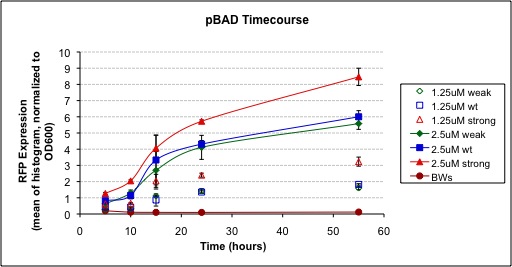Team:British Columbia/pBAD
From 2009.igem.org
| Line 9: | Line 9: | ||
Above is a sequence alignment of our promoter variants with the wild type pBAD, truncated for space. For the full sequences, see our parts in the registry at <partinfo>K206000</partinfo> (strong) and <partinfo>K206001</partinfo> (weak). | Above is a sequence alignment of our promoter variants with the wild type pBAD, truncated for space. For the full sequences, see our parts in the registry at <partinfo>K206000</partinfo> (strong) and <partinfo>K206001</partinfo> (weak). | ||
| - | <html> | + | <html>Using these promoter sequences, we assembled XXX...</html> |
[[Image:Timecourse.jpg]] | [[Image:Timecourse.jpg]] | ||
[[Image:Toxicity.jpg]] | [[Image:Toxicity.jpg]] | ||
[[Image:Trans_fcn.jpg]] | [[Image:Trans_fcn.jpg]] | ||
Revision as of 19:16, 20 October 2009
Home Team Traffic Light Sensor Lock&Key Jammer [http://partsregistry.org/cgi/partsdb/pgroup.cgi?pgroup=iGEM2009&group=British_Columbia Parts] Safety Sponsors Notebook Bibliography
Overview
In order to make an analog biosensor, we need our traffic light to be able to respond differently to different concentrations of an input. However, the Registry is lacking in variable strength inducible promoters. We designed two variants of the pBAD promoter, one weaker and one stronger, based on AraC binding experiments performed by Niland et al.
pbad wt ACATTGATTATTTGCACGGCGTCACACTTTGCTATGCCATAGCATTTTTATCCATAAGATTAGCGGATCCTACCTGACGCTTTTT... pbad weak ACATTGATTATTTGCACGGCGTCACACTTTGCTATGCCATAGCTTTTTTATCCATAAGATTAGCGGATCCTACCTGACGCTTTTT... pbad strong ACATTGATTATTTGCACGGCGTCACACTTTGCTATGCCATAGCAAGATAGTCCATAAGATTAGCGGATCCTACCTGACGCTTTTT...
Above is a sequence alignment of our promoter variants with the wild type pBAD, truncated for space. For the full sequences, see our parts in the registry at (strong) and (weak).
Using these promoter sequences, we assembled XXX...



 "
"